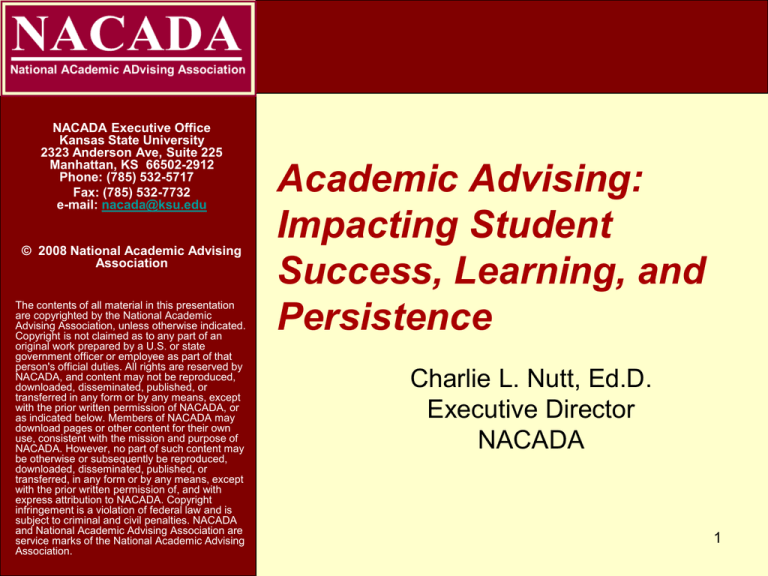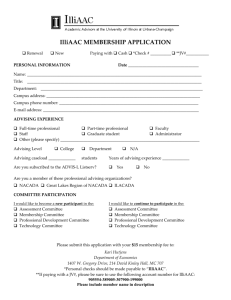
NACADA Executive Office
Kansas State University
2323 Anderson Ave, Suite 225
Manhattan, KS 66502-2912
Phone: (785) 532-5717
Fax: (785) 532-7732
e-mail: nacada@ksu.edu
© 2008 National Academic Advising
Association
The contents of all material in this presentation
are copyrighted by the National Academic
Advising Association, unless otherwise indicated.
Copyright is not claimed as to any part of an
original work prepared by a U.S. or state
government officer or employee as part of that
person's official duties. All rights are reserved by
NACADA, and content may not be reproduced,
downloaded, disseminated, published, or
transferred in any form or by any means, except
with the prior written permission of NACADA, or
as indicated below. Members of NACADA may
download pages or other content for their own
use, consistent with the mission and purpose of
NACADA. However, no part of such content may
be otherwise or subsequently be reproduced,
downloaded, disseminated, published, or
transferred, in any form or by any means, except
with the prior written permission of, and with
express attribution to NACADA. Copyright
infringement is a violation of federal law and is
subject to criminal and civil penalties. NACADA
and National Academic Advising Association are
service marks of the National Academic Advising
Association.
Academic Advising:
Impacting Student
Success, Learning, and
Persistence
Charlie L. Nutt, Ed.D.
Executive Director
NACADA
1
Making the simple complicated is
commonplace. Making the complicated
simple, awesomely simple, that’s
creativity.
Charles Mingus
2
People will forget what you say.
They will even forget what you do.
But they never forget how you made
them feel.
Maya Angelou
3
Advising is viewed as a way to connect
students to the campus and help them
feel that someone is looking out for
them.
George Kuh
Student Success in College (2005)
4
Good advising may be the single most
underestimated characteristic of a
successful college experience.
Richard Light
Making the Most of College (2001)
5
Advisors are interpreters who help
students navigate their new world. As
such, academic advisors have to make
connections.
Nancy King
Kennesaw State University
6
Advising and Retention
In a 2004 Pell Institute Report, Tinto
states the campuses that support
student retention must have programs
that:
Teach students how to make decisions
effectively
Teach students how to investigate and
make decisions on careers and majors
Teach students how to maneuver higher
education channels and to identify and
utilize support services
7
Advising and Retention
In another Pell Institute Study (Dec
2004), common elements of ten
institutions with higher than expected
graduation rates were identified:
Intentional, focused, and intrusive academic
planning programs existed
High student participation in programs that
provide academic advising and academic
support
8
Advising and Retention
Educational innovations to assist students
with ease to college, adjustment to college,
and maneuvering higher education from
entrance to graduation.
9
Advising and Retention
WHAT DO STUDENTS
WANT FROM ADVISORS?
Accurate Information
“Do they know?”
Accessibility
“Are they there?”
Caring Attitude
“Do they care?”
10
Engagement
The intersection of student
behaviors and institutional
conditions over which colleges and
universities have at least marginal
control.
Kuh, et al, 2007.
Institutional Conditions
Educationally effective institutions
channel student energy toward the
right activities.
Student Behaviors
What matters most is what
students do and the effort they
expend, not who they are.
BUT…
But Who They Are Affects What
Students Do and the Effort They Expend
Understanding This is Important to
Designing Academic Advising Programs
The Psychology of Leaving (or
Staying): Intentions and Attitudes
The intention to leave (or stay) is the best
predictor of actual student departure.
Intentions are the by-product of the
interaction of the student and the
institution
Faculty
Other Students
Administrators and Staff Members
Bean, 2005
**NEWSFLASH**NEWSFLASH**NEWSFLASH**
Attitudes affect Intentions
Influencing Attitudes and Intentions
Good advising should link a student’s
academic capabilities with his or her choice
of courses and major, access to learning
resources, and a belief that the academic
pathway a student is traveling will lead to
employment after college.
Advising should be done well so students
recognize their abilities and make informed
choices.
Bean, 2005
In the End, Good Advising Can and
Should Contribute To
Academic and Social Integration
resulting from positive experiences that
increase:
satisfaction with being a student at a given
institution,
confidence in one’s ability,
academic competence, and
one’s understanding his/her educational,
career and life goals.
Five Strategies for
Advisors to Focus on
Student Success
1. Adopt a Talent Development
Approach to Advising
Know your students
Who are they? What are they telling
you?
An entitlement mentality
Cumulative deficits in attitudes, study habits,
academic skills
More diverse than previous groups
Techno-savvy “NetGens”
1. Adopt a Talent Development
Approach to Advising
Meet students “where they are”—
academically, socially,
psychologically, culturally
Set high expectations—challenge,
implore, cajole, and support
2. Make Advising a Tag Team Activity
Share responsibility for student
success
Draw on multiple sources of expertise
and perspectives on students
3. Help Students Map Out a Path to
Success
Draw a Map for student success
Teach newcomers about the campus
culture
Emphasize student initiative
Point students to programs,
resources, and activities that work
4. Make Every Interaction Meaningful
Participate and connect before
college and during orientation
Provide accurate information
Push students to THINK!!
Develop peer mentoring programs
Imbed advising into a first-year
program
Encourage students to experience
diversity early
5. Focus on Culture Sooner Than
Later
Identify cultural properties that
impede advisor effectiveness and
student success
Expand the number of cultural
practitioners in advising
Install an ethic of positive cultural
communication
Thank You!
References
Astin, A. 1993. What matters in college? : Four critical years revisited. San Francisco:
Jossey-Bass, publishers.
Bean, J.P. 2005. “Nine themes of College Student Retention”, in Alan Seidman (ed.),
College student retention. Westport, Connecticut: Praeger Publishers.
Bean, J. and Eaton, S.B. 2002. “A Psychological Model of College Student Retention”, in
John M. Braxton, Reworking the student departure puzzle. Nashville, Tennessee:
Vanderbilt University Press.
Berdahl, R. O. 1995. “Educating the Whole Person”, in New Directions for Teaching &
Learning. San Francisco: Jossey-Bass, publishers.
Council for the Advancement of Standards. CAS Standards for Academic Advising
Programs. Retrieved June 27, 2007 from
http://www.nacada.ksu.edu/Clearinghouse/Research_Related/CASStandardsForAdvi
sing.pdf
Crookston, (1972) Crookston, B. B. (1972). “A Developmental View of Academic
Advising as Teaching”, in Journal of College Student Personnel, volume 13, pp. 1217.
Habley, W. 1981. NASPA Journal
Kuh, G.D. 2008. High-impact educational practices. Washington, D.C.: AAC&U.
Kuh, G.D., Kinzie, J., Schuh, J.H., Whitt, E.J. and Associates . 2005. Student success in
college: Creating conditions that matter. San Francisco: Jossey-Bass, publishers.
Lewin, K 1997. Resolving social conflicts & field theory in social science. Washington,
D.C.: American Psychological Association.
28
Lowenstein, M. Fall, 2005. “If teaching is advising, what do advisors teach?”
www.nacada.ksu.edu/AAT/NW30_2.htm
Macfarlane, B. 2007. The academic citizen: The virtue of service in university life. New
York: Routledge Publishing.
Magolda, M.B. and King, P.M. Winter 2008. “Toward Reflective Conversations: An
Advising Approach that Promotes Self-Authorship”, in Peer Review, Vol. 10, No. 1.
Washington, D.C.: AAC&U.
Mezirow, J. Ed. 2000. Learning as transformation: Critical perspectives on a theory in
progress. San Francisco: Jossey-Bass.
National Academic Advising Association. 2006. NACADA concept of academic advising.
Retrieved June 27, 2007 from
http://www.nacada.ksu.edu/Clearinghouse/AdvisingIssues/Concept-Advising.htm
Thomas, L and Hixenbaugh, P., eds. 2006. Personal tutoring in higher education. Stoke
on Trent, UK: Trentham Books
Tinto, V. 1993. Leaving college: Rethinking the causes and cures of student attrition.
San Francisco: Jossey-Bass, publishers.
Tinto, V “Taking Student Retention Seriously.” Retrieved April 24, 2007 from
http://soeweb.syr.edu/Facuty/Vtinto/
29

